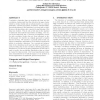Free Online Productivity Tools
i2Speak
i2Symbol
i2OCR
iTex2Img
iWeb2Print
iWeb2Shot
i2Type
iPdf2Split
iPdf2Merge
i2Bopomofo
i2Arabic
i2Style
i2Image
i2PDF
iLatex2Rtf
Sci2ools
113
Voted
KDD
2006
ACM
2006
ACM
Deriving quantitative models for correlation clusters
Correlation clustering aims at grouping the data set into correlation clusters such that the objects in the same cluster exhibit a certain density and are all associated to a common arbitrarily oriented hyperplane of arbitrary dimensionality. Several algorithms for this task have been proposed recently. However, all algorithms only compute the partitioning of the data into clusters. This is only a first step in the pipeline of advanced data analysis and system modelling. The second (post-clustering) step of deriving a quantitative model for each correlation cluster has not been addressed so far. In this paper, we describe an original approach to handle this second step. We introduce a general method that can extract quantitative information on the linear dependencies within a correlation clustering. Our concepts are independent of the clustering model and can thus be applied as a post-processing step to any correlation clustering algorithm. Furthermore, we show how these quantitative ...
Correlation Clustering | Correlation Clustering Algorithm | Correlation Clusters | Data Mining | KDD 2006 |
Related Content
| Added | 30 Nov 2009 |
| Updated | 30 Nov 2009 |
| Type | Conference |
| Year | 2006 |
| Where | KDD |
| Authors | Arthur Zimek, Christian Böhm, Elke Achtert, Hans-Peter Kriegel, Peer Kröger |
Comments (0)

